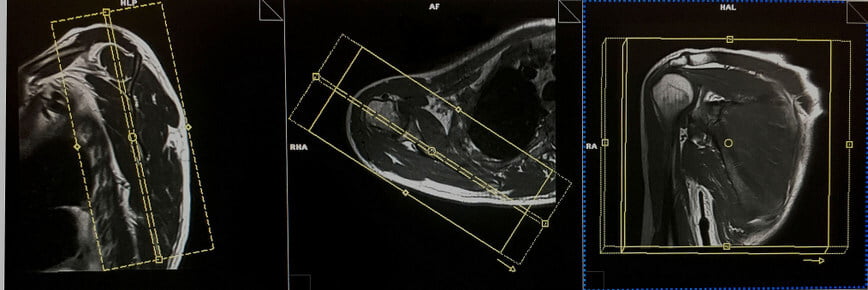Scapula MRI : Protocol and Planning
Indications for MRI Scapula
- Marrow abnormalities e.g. bone contusions, osteonecrosis, marrow edema syndromes
- Infections of bone, joint, or soft tissue e.g. osteomyelitis, osteochondritis, myositis
- Langerhans cells histiocytosis or eosinophilic granuloma
- Fibromas in the scapular region
- Ostechondroma
- Osteoblastoma
- Aneurysmal bone cyst
- Giant cell Tumour
- Elastofibroma dorsii
- Malignant Fibrous hisiocytoma
- Osteosarcoma
- Chondrosarcoma
- Multiple myeloma
- Metastatic disease
- Ewing's sarcoma
- Congenital elevation of the scapula
- Gorham's disease of scapula
- Paget disease
- Ligament tear
- Muscular injurys
Contraindications
- Any electrically, magnetically or mechanically activated implant (e.g. cardiac pacemaker, insulin pump biostimulator, neurostimulator, cochlear implant, and hearing aids)
- Intracranial aneurysm clips (unless made of titanium)
- Pregnancy (risk vs benefit ratio to be assessed)
- Ferromagnetic surgical clips or staples
- Metallic foreign body in the eye
- Metal shrapnel or bullet
Patient preparation for MRI Scapula
- A satisfactory written consent form must be taken from the patient before entering the scanner room
- Ask the patient to remove all metal objects including keys, coins, wallet, cards with magnetic strips, jewellery, hearing aid and hairpins
- If possible provide a chaperone for claustrophobic patients (e.g. relative or staff )
- Offer earplugs or headphones, possibly with music for extra comfort
- Explain the procedure to the patient
- Instruct the patient to keep still
- Note the weight of the patient
Positioning for MRI Scapula
- Position patient in the supine position with head pointing towards the magnet (head first supine).
- Position the patient off-center over the spine coil as demonstrated, and place the large flexible coil over the shoulder and upper arm. Adjust the flex coil so that it is positioned more towards the affected side.
- Securely tighten the body coil using straps to prevent respiratory artefacts
- The patient may be given a pillow and cushions under their legs for extra comfort
- Centre the laser beam localiser over the sternoclavicular joint
- Register the patient on the scanner as 'head first supine'

Recommended MRI Scapula Protocols and Planning
Localiser 1
A three-plane localizer must be taken in the beginning to localize and plan the sequences. Localizers are usually less than 25 seconds. T1-weighted low-resolution scans are used for this purpose.

Localiser 2
Plan the coronal and sagittal localizers on the axial plane. For the coronal localizer, angle the position block parallel to the scapular blade, and for the sagittal localizer, angle the position block perpendicular to the scapular blade. For a further axial localizer, position the block perpendicular to the scapular blade on the sagittal plane.

T2 stir axial 3mm SFOV
Plan the axial slices on the coronal plane and angle the positioning block horizontally across the scapular blade. Check the positioning block in the other two planes. An appropriate angle must be used in the sagittal plane, perpendicular to the scapular blade. Slices must be sufficient to cover the whole scapula from the top of the acromioclavicular joint to 1 cm below the inferior angle of the scapula. Adding saturation bands over the chest will help reduce ghosting artifacts from breathing. The phase direction must be anteroposterior with sufficient oversampling to avoid wrap-around and ghosting artifacts from the chest.

Parameters
TR 4000-5000 | TE 110 | FLIP 160 | NEX 2 | SLICE 3 MM | MATRIX 256X256 | FOV 220-250 | PHASE A>P | GAP 10% | TI 160 |
T1 tse axial 3mm SFOV
Plan the axial slices on the coronal plane and angle the positioning block horizontally across the scapular blade. Check the positioning block in the other two planes. An appropriate angle must be used in the sagittal plane, perpendicular to the scapular blade. Slices must be sufficient to cover the whole scapula from the top of the acromioclavicular joint to 1 cm below the inferior angle of the scapula. Adding saturation bands over the chest will help reduce ghosting artifacts from breathing. The phase direction must be anteroposterior with sufficient oversampling to avoid wrap-around and ghosting artifacts from the chest.

Parameters
TR 400-600 | TE 15-25 | SLICE 3 MM | FLIP 160 | PHASE A>P | MATRIX 320X320 | FOV 220-250 | GAP 10% | NEX(AVRAGE) 2 |
T1 tse coronal 3mm SFOV
Plan the coronal slices on the axial plane and angle the positioning block parallel to the scapular blade. It’s essential not to exceed a 45° angle with the block, as angling beyond this limit will cause the coronal image to transform into a sagittal image. Check the positioning block in the other two planes. In the sagittal plane, use an appropriate angle parallel to the scapular blade. Ensure that the slices adequately cover the entire scapula, from the anterior portion of the coracoid process to the posterior skin margin. To reduce ghosting artifacts caused by breathing, consider adding an oblique saturation band over the chest. For the phase direction, use right to left with sufficient oversampling to prevent wrap-around and ghosting artifacts from the chest.
Parameters

TR 400-600 | TE 15-25 | SLICE 3 MM | FLIP 130 | PHASE R>L | MATRIX 320X320 | FOV 200-250 | GAP 10% | NEX(AVRAGE) 2 |
T2 stir coronal 3mm SFOV
Plan the coronal slices on the axial plane and angle the positioning block parallel to the scapular blade. It’s essential not to exceed a 45° angle with the block, as angling beyond this limit will cause the coronal image to transform into a sagittal image. Check the positioning block in the other two planes. In the sagittal plane, use an appropriate angle parallel to the scapular blade. Ensure that the slices adequately cover the entire scapula, from the anterior portion of the coracoid process to the posterior skin margin. To reduce ghosting artifacts caused by breathing, consider adding an oblique saturation band over the chest. For the phase direction, use right to left with sufficient oversampling to prevent wrap-around and ghosting artifacts from the chest.

Parameters
TR 4000-5000 | TE 110 | FLIP 130 | NEX 2 | SLICE 3 MM | MATRIX 320X256 | FOV 200-250 | PHASE R>L | GAP 10% | TI 150 |
T2 tse sagittal
Plan the agittal slices on the axial plane and position the block perpendicular to the scapular blade. Verify the positioning block in the other two planes. Provide an appropriate angle in the coronal plane, running vertically across the scapular blade. Ensure that the slices cover the entire scapula, extending from the lateral edge of the deltoid muscle to 1 cm past the medial border of the scapula. To minimize ghosting artifacts caused by breathing, incorporate an oblique saturation band over the chest. Choose the phase direction as either anteroposterior or head to feet, with ample oversampling to prevent wrap-around and ghosting artifacts.

Parameters
TR 4000-5000 | TE 110 | FLIP 150 | NEX 2 | SLICE 3MM | MATRIX 320X320 | FOV 200-250 | PHASE A>P/H>F | GAP 10% | FATSAT Off |
